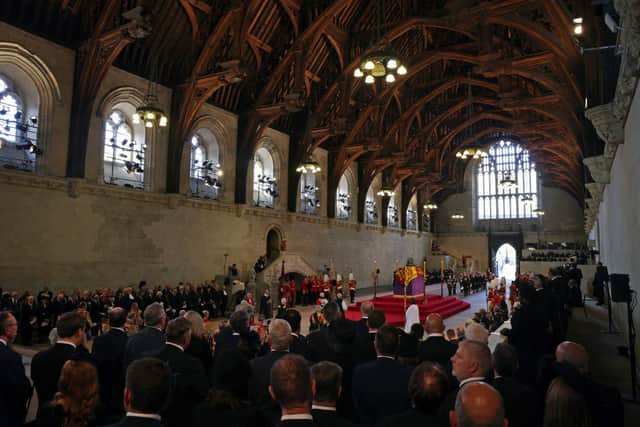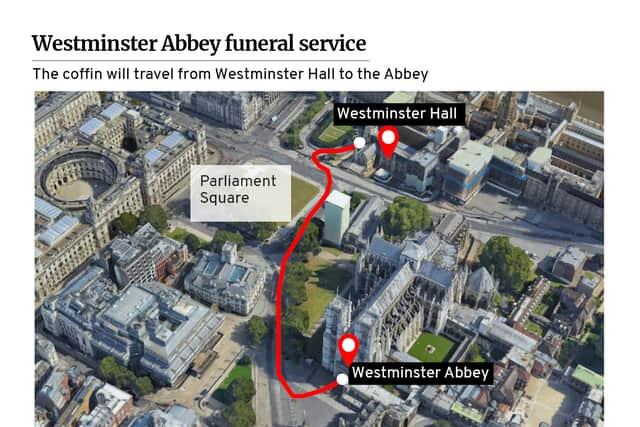Westminster Hall: where in London is it, when was it built, map - history of building as Queen lying in state
and live on Freeview channel 276
A constant procession of mourners is continuing to make its way through Westminster Hall to pay their respects to the Queen, who is lying-in-State.
The queue of mourners reaches back for miles and stretches along the South Bank of London’s River Thames.
Advertisement
Hide AdAdvertisement
Hide AdMany who patiently waited in line for hours have spoken of the overwhelming emotions of finally walking into the grand hall, the history, colours and grandeur of the place only adding to a bewildering moment.
But what exactly is the history of the building, and which other monumental occasions have taken place there throughout time?
Here is everything you need to know.
When was Westminster Hall built?


Westminster Hall is situated at the heart of the Palace of Westminster, emptied of its usual visitors’ desks and displays and chattering groups.
Earlier this month (12 September), King Charles III described it as a “great hall” which holds “reminders of medieval predecessors of the office to which I have been called” during a speech given to MPs and peers in Parliament.
Advertisement
Hide AdAdvertisement
Hide AdIt dates back more than 900 years, and construction began in 1097 under William II (Rufus), the son of William the Conqueror - building work was completed two years later.
According to the UK Parliament website, the hall was created to impress William II’s new subjects with his power and the majesty of his authority.
It measures 240ft (73.2m) long, 68ft (20.7m) wide and 92ft (28m) high.


It holds the title of Europe’s largest unsupported medieval roof, though the ceiling was originally supported by two rows of pillars - in 1399, Richard II wanted to make the hall more impressive by making it unsupported.
Advertisement
Hide AdAdvertisement
Hide AdIt was a challenge met by carpenter Hugh Herland and architect Henry Yevele by building huge hammer-shaped oak beams and strengthening the walls.
Westminster Hall has twice escaped destruction, following the fire of 1834 caused by an overheating stove overheating which razed the rest of the Palace of Westminster to the ground, and during the Second World War when German bombers dropped a dozen bombs on the neighbouring House of Commons chamber.
What other historic events have taken place in Westminster Hall?
Charles’ address was the latest to take place in the hall, a location which has been used to mark momentous moments in British history.
In the 14th century the hall became a centre of London life, housing the law courts and selling a host of legal paraphernalia including wigs, pens and books.
Advertisement
Hide AdAdvertisement
Hide AdIt was the scene of the trial of Guy Fawkes and his fellow Gunpowder Plot conspirators in 1606, and King Charles I, who was tried for treason and beheaded in the 17th century.
Despite the hall being used as the location for several royals and former prime ministers to lie in state, the Queen’s husband, the Duke of Edinburgh, did not follow suit after his death in 2021.
In accordance with his wishes, the duke did not lie in state, however his death also took place during the Covid-19 crisis and at that point such mass gatherings were against the law.
But the hall has also been used for celebrations to mark important moments in British history, such as the 50th anniversary of the end of the Second World War and the Queen’s Silver Jubilee in 1977, Golden Jubilee in 2002 and Diamond Jubilee in 2012.
Advertisement
Hide AdAdvertisement
Hide AdOn occasions, the hall is also used as the venue for world leaders to give addresses to both Houses of Parliament - the House of Lords and the House of Commons.
A foreign leader being asked to address the Houses is considered a rare honour, and since the Second World War, only French President Charles de Gaulle in 1960, South African President Nelson Mandela in 1996, Pope Benedict XVI in 2010, US President Barack Obama in 2011, and Burmese opposition leader Aung San Suu Kyi in 2012 have done so.
Comment Guidelines
National World encourages reader discussion on our stories. User feedback, insights and back-and-forth exchanges add a rich layer of context to reporting. Please review our Community Guidelines before commenting.
